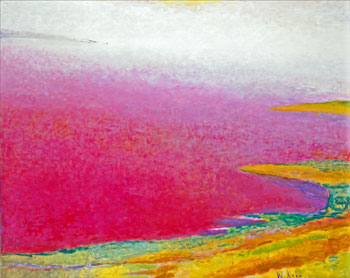
Easy Pleasure
Wolf Kahn’s pastels at Ameringer & Yohe
by Maureen Mullarkey
CAN ART THIS INGRATIATING BE TAKEN SERIOUSLY? The question dogs critical appraisal of Wolf Kahn. His popularity with a broad public and the unclouded loveliness of his landscapes give rise to grumblings that he has not earned his keep. His lyrical paintings and pastels, on view in two successive shows at Ameringer & Yohe, are so easy to like that they offend against the inherited mantle of vanguardism that marked his early career.
 |
| Wolf Kahn, Seaweed Fingers,
Oil on canvas |
The contemporary assumption that art of any importance does not lend itself to easy pleasure is a conceit that feeds on a misunderstanding of terms. Without regard to content or style, art stands in criticism of life by its very nature. Art is wholly a result of individual dominion, a product of control and volition. Chance effects can be retained as “happy accidents” or scraped away. Not so the accidents of living.
Few know that better than the German-born Mr. Kahn, whose family fled Stuttgart in 1939, when he was 12.
The Kahns immigrated to the United States by way of England the following year. Wolf graduated from New York’s High School of Music and Art in 1945 and served briefly in the Navy. Under the GI Bill, he studied with another refugee from Hitler’s Germany, Hans Hofmann. He became Hofmann’s studio assistant and part of the circle of second-generation abstract expressionists.
Abstraction was considered gutsy when Mr.Kahn began his career in the early fifties. Painting seemed, for the moment, about to reclaim its stature as a dominant medium within an image-saturated culture of mass communication. At the time, revolt against representation was implicitly a resistance to mass culture, a high calling.
Mr. Kahn side-stepped the exaggerated sonority and thunder of abstract expressionism by keeping faith, however freely, with physical reality. In his own words: “I believe above all that art exists to celebrate, exalt and excite, and satisfy the demands of the visual.”
His early abstractions, in the manner of Soutine, skirted representation without fully abandoning it. His hold on natural forms gradually tightened. It has continued to enliven his own color field tendencies lomg after color field painting subsided into a stylish footnote to abstraction.
The title of this double show, “Sizing Up,” invites us to do just that—to estimate Mr. Kahn’s standing as an heir to Hans Hofmann’s legacy. The splendid exhibition of paintings that ran from the end of April to June 1st provided ample reason to see Mr. Kahn as a painter to be reckoned with. Over the decades, his synthesis of realism and abstraction has remained rigorous and sophisticated.
His chromatic inventiveness is beautifully apparent in the large oils. “Seaweed Fingers” (1999) rises in glowing bands from a hem of golds, greens, blues and dark orange to a fuschia field that gradually pales into lavender-pink then into an opalescent strip of white. Upward movement is crowned by a sliver of pale yellow that echoes the warmth of the lower stripe. Mediterranean in spirit and pulsing with light, it recalls Bonnard in brushwork that adjusts each variegated stroke of color to its place in the larger scheme.
“Swamp II” is a tall, delicately drawn distillation of a stand of trees in a patch of wetland. Slender silver-white trunks ascend from mottled gold and orange ponds toward a pale sky. Trees, with their lacy scatter of branches, shimmer against a blue field. The painting gracefully transcends realistic description. It depicts instead the sensations of the scene, stripped of anecdote and rendered in chaste scumbles over a cobalt surface
Anyone who visited the painting half of this show, will likely feel a tad let down by the subsequent hanging of recent pastels. It is a tepid finale. Pastel is a sketchy medium, conducive to cursory mark-making. While certain images hold their own against the paintings, many suggest a different level of ambition. Thin flurries of color stand bail for more substantial rendering. The flat brown “Barn With White Doors” (2007) comes dangerously close to banality.
If you take — as I do — Degas’s pastel landscapes as the standard of what can be done with chalk on paper, Mr. Kahn’s tend to lack texture and chromatic depth. Colors are identical to those in the painting: genial pinks, oranges, violets and blues. But the body is gone out of them. All are pleasant but only some sustain the subtle dialogue between structure and tonality that characterize his oils. “More Orange” 2006 is certainly one of them. So is “Through a Range of Colors” (2006).
Like Degas, Mr, Kahn is not a plein air painter. He told Alan Gussow in the 1970s: “ I can see nature most clearly in my studio, undistracted by trees and skies. Art being emotion recollected in tranquility, I constantly find nature too emotional and Broadway very tranquil.” That tranquility makes itself felt most robustly in the oils.




“Wolf Kahn: Sizing up” at Ameringer & Yohe (20 W. 57 Street, 212-445-0051).
This review appeared first in The New York Sun, 28 June 2007.
Copyright 2007, Maureen Mullarkey







